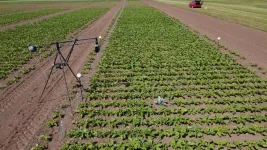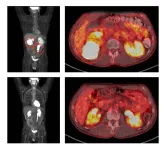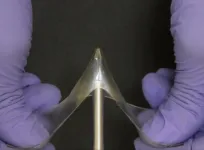(Press-News.org) A demonstration of how new technologies can be used in 21st century crop breeding comes from just published research that combines Laser Scanning and 3D printing to create a detailed 3D model of a sugar beet plant. Taking the next step beyond having genetic information to guide intelligent breeding, the 3D plant models here capture the essential characteristics of the above-ground parts of the sugar beet plant and can be used for AI-assisted crop improvement pipelines. The sugar beet plant models are reproducible and fit for field use. All the research information, data, methodology, as well as the 3D printing files are freely available. Crop management is gaining much needed tools, and, of course, everyone can now print their own 3D sugar beet plant! (Minimum maintenance required.) The sugar beet plant 3D model and its validation are presented in a new publication in the open science journal GigaScience.
Modern plant breeding is a data-centric enterprise, involving machine learning algorithms and sophisticated imaging technology to select desirable traits. “Plant phenotyping” - the science of gathering precise information and measurements on plants - has seen massive improvements over the last couple of years.
In the past, phenotyping relied on measurements taken tediously by humans. Today, phenotyping pipelines are becoming more and more automated, using state-of-the-art sensor technology, often assisted by artificial intelligence. Measurements taken can include size, fruit quality, leaf shape and size, and other growth parameters. In addition to the efficiency gains of handing over the measurement work to automated pipelines, computer-assisted sensors can often capture complex information about a plant that would be very hard for humans to gather on a large scale.
One crucial aspect in this new, sensor-driven world of crop breeding is the availability of precise reference material.
The sensors need to be presented with data on a “standard plant” that encompass all relevant characteristics, including also more complex, 3-dimensional traits such as the angle at which the leaves are oriented. Having an actual “artificial plant” as a real-size reference is therefore preferable to just having data in the computer, or a flat, 2D representation. An actual model can, for example, also be included as a reference and internal control within a green house or test field among the real plants.
The new 3D-printed model of a sugar beet plant was generated with these applications in mind and has the additional advantage that the printing files are available for free download and reuse. This allows other scientists (and any sugar beet enthusiast, really) to recreate an exact copy of the reference sugar beet, making research done by different labs in different parts of the world more comparable. The affordability of 3D printing also means the approach can be adapted in resource poor settings, for example in developing countries.
To gather the precise data for their realistic model, the authors - Jonas Bömer and colleagues from the Institute of Sugar Beet Research (Göttingen) and the University of Bonn - used LIDAR (Light Detection and Ranging) technology. In short, a real sugar beet plant was scanned by a laser to create 3D data from 12 different viewing angles. After processing steps, this data was then fed into a commercial-grade 3D printer to create the actual real-size model of the sugar beet. The authors then tested the model for its intended use as point of reference, in the lab and in the field.
Jonas Bömer explains: "In the field of three-dimensional plant phenotyping, the referencing of utilized sensor systems, computer algorithms and captured morphological parameters represents a challenging yet fundamentally important task. The application of additive manufacturing technologies for the generation of reproducible reference models presents a novel opportunity to develop standardized methodologies for objective and precise referencing, thereby benefiting both scientific research and practical plant breeding."
The approach is not restricted to sugar beet of course, and the new GigaScience study demonstrates how the combination of artificial intelligence, 3D printing, and sensor technology can contribute to the plant breeding of the future - thus helping to feed the world’s population with healthy, delicious crops. GigaScience data scientist Chris Armit adds: “The value in a printable 3D model is that you can print multiple copies, one per field of crops. As a low-cost phenotyping strategy, where the major cost is the LIDAR scanner, it would be fantastic to see this approach tested on other crops such as rice or African orphan crops, where there is a need for low-cost phenotyping solutions.”
Further Reading:
Bömer J; Esser F; Marks EA; Rosu RA; Behnke S; Klingbeil L; Kuhlmann H; Stachniss C; Mahlein AK; Paulus S. A 3D printed plant model for accurate and reliable 3D plant phenotyping. GigaScience 2024. doi:10.1093/gigascience/giae035
Data Availability:
Bömer J; Esser F; Marks EA; Rosu RA; Behnke S; Klingbeil L; Kuhlmann H; Stachniss C; Mahlein AK; Paulus S (2024): Supporting data for "A 3D printed plant model for accurate and reliable 3D plant phenotyping" GigaScience Database. https://doi.org/10.5524/102530
Multimedia:
Video: https://youtu.be/RwdmNIq-KMk
Printable 3D model in Thingiverse: https://www.thingiverse.com/thing:6626202
Browsable/embeddable 3D models in Sketchfab
https://sketchfab.com/GigaDB/collections/sugar-beet-leaf-point-cloud-996ac99350cb451fa341eaddbc451382
Media contacts:
GigaScience, Editor-in-Chief:
Scott Edmunds, Scott@gigasciencejournal.com, Cell: +852 92490853
Expert:
Jonas Bömer, boemer@ifz-goettingen.de, Tel: +49551505682
Sharing on social media?
Find GigaScience online on twitter: @GigaScience, @GigabyteJournal, @Giga_DB; Facebook https://www.facebook.com/GigaScience, and keep up-to-date with our blog http://gigasciencejournal.com/blog
About GigaScience Press
GigaScience Press is BGI's Open Access Publishing division, which publishes scientific journals and data. Its publishing projects are carried out with international publishing partners and infrastructure providers, including Oxford University Press and River Valley Technologies. It currently publishes two award-winning data-centric journals: its premier journal GigaScience (launched in 2012), which won the 2018 American Publishers PROSE award for innovation in journal publishing, and its new journal GigaByte (launched 2020), which won the 2022 ALPSP Award for Innovation in Publishing. The press also publishes data, software, and other research objects via its GigaDB.org database. To encourage transparent reporting of scientific research and to enable future access and analyses, it is a requirement of manuscript submission to all GigaScience Press journals that all supporting data and source code be made openly available in GigaDB or in a community approved, publicly available repository. Curating 3D data the GigaDB team also make this data usable by the 3D printing community in Thingiverse (see https://www.youtube.com/watch?v=EHSbeDFN_k8).
About GigaScience
GigaScience is co-published by GigaScience Press and Oxford University Press. Winner of the 2018 PROSE award for Innovation in Journal Publishing (Multidisciplinary), the journal covers research that uses or produces 'big data' from the full spectrum of the biological and biomedical sciences. It also serves as a forum for discussing the difficulties of and unique needs for handling large-scale data from all areas of the life and medical sciences. The journal has a completely novel publication format -- one that integrates manuscript publication with complete data hosting, and analyses tool incorporation. To encourage transparent reporting of scientific research as well as enable future access and analyses, it is a requirement of manuscript submission to GigaScience that all supporting data and source code be made available in the GigaScience database, GigaDB, as well as in publicly available repositories. GigaScience will provide users access to associated online tools and workflows, and has integrated a data analysis platform, maximizing the potential utility and re-use of data.
END
Improving crops with laser beams and 3D printing
Researchers use laser scanning to generate 3D models of the above ground parts of the sugar beet plant from a crop field, providing a step forward in developing AI-assisted crop pipeline improvement
2024-06-20
ELSE PRESS RELEASES FROM THIS DATE:
Government’s failure to fortify all flour and rice with sufficient folic acid will lead to avoidable birth defects, warns expert
2024-06-20
The UK government’s failure to fortify all flour and rice with the vitamin folic acid “will result in more deaths and birth defects every year that could have been prevented,” argues Professor Sir Nicholas Wald in The BMJ today.
He warns that the current government’s proposal to fortify only one type of flour (non-wholemeal wheat flour) at an inadequate level will prevent only about 20% of neural tube defects, much less than the approximate 80% that could be prevented with fully effective fortification.
“What the government has done is a useful ...
Walking brings huge benefits for low back pain, study finds
2024-06-20
Adults with a history of low back pain went nearly twice as long without a recurrence of their back pain if they walked regularly, a world-first study has found.
About 800 million people worldwide have low back pain, and it is a leading cause of disability and reduced quality of life.
Repeated episodes of low back pain are also very common, with seven in 10 people who recover from an episode going on to have a recurrence within a year.
Current best practice for back pain management and prevention suggests the combination of ...
Study finds one copy of protective genetic variant helps stave off early-onset Alzheimer’s disease
2024-06-19
KEY TAKEAWAYS
An international team, including researchers from Mass General Brigham, has been searching for protective genetic variants in a family that includes more than 1,000 individuals who are genetically predisposed to develop early onset Alzheimer’s disease in their 40s.
Previously, the researchers identified the “Christchurch variant” as potentially protective against Alzheimer’s based on one family member who had two copies of this variant and was expected to develop dementia in her ...
Combination targeted treatment produces lasting remissions in people with resistant aggressive B-cell lymphoma
2024-06-19
Embargoed for Release
Wednesday, June 19, 2024
5:00 p.m. ET Contact: NCI Press Office
240-760-6600
NCIPressOfficers@nih.gov
NOTE: A virtual briefing is scheduled for Tuesday, June 18, 2024, at 1:00 p.m. ET. Details below.
Researchers at the National Institutes of Health (NIH) have developed a non-chemotherapy treatment regimen that is achieving full remissions for some people with aggressive B-cell lymphoma that has come back or is no longer responding to standard treatments. The five-drug combination targets multiple molecular pathways that diffuse large B-cell lymphoma (DLBCL) tumors use to survive.
In ...
Common prostate drugs tied to lower risk of dementia with lewy bodies
2024-06-19
EMBARGOED FOR RELEASE UNTIL 4 P.M. ET, WEDNESDAY, JUNE 19, 2024
MINNEAPOLIS – Certain drugs used to treat urinary symptoms due to an enlarged prostate may be associated with a reduced risk of dementia with Lewy bodies, according to a study published in the June 19, 2024, online issue of Neurology®, the medical journal of the American Academy of Neurology. Dementia with Lewy bodies is a progressive neurodegenerative disorder that can cause memory and thinking issues, movement problems and issues such as hallucinations.
The results do not prove that these drugs reduce the risk of dementia ...
Drugs for enlarged prostate may also protect against dementia with Lewy bodies
2024-06-19
A new study suggests that certain drugs commonly used to treat enlarged prostate may also decrease the risk for dementia with Lewy bodies (DLB). This observational finding may seem surprising, but it mirrors previous work by the University of Iowa Health Care team that links the drugs to a protective effect in another neurodegenerative condition–Parkinson's disease.
The UI researchers think that a specific side effect of the drugs targets a biological flaw shared by DLB and Parkinson’s disease, as well as other neurodegenerative ...
Titan’s lakes may be shaped by waves
2024-06-19
Titan, Saturn’s largest moon, is the only other planetary body in the solar system that currently hosts active rivers, lakes, and seas. These otherworldly river systems are thought to be filled with liquid methane and ethane that flows into wide lakes and seas, some as large as the Great Lakes on Earth.
The existence of Titan’s large seas and smaller lakes was confirmed in 2007, with images taken by NASA’s Cassini spacecraft. Since then, scientists have pored over those and other images for clues to the moon’s mysterious ...
YALE EMBARGOED NEWS: Family psychiatric history: Effects on siblings of children with autism
2024-06-19
New Haven, Conn. — Children who have an older sibling with autism spectrum disorder (autism) are at greater risk of developmental vulnerabilities if they also have other relatives with neurodevelopmental or psychiatric conditions, according to a new study from the Yale Child Study Center.
Researchers found that the siblings of children with autism had an increase in the severity of social and communication difficulties — which are common in autism — if they had relatives with conditions such as schizophrenia or anxiety. Family histories of anxiety and intellectual disability were also associated ...
New technology provides electrifying insights into how catalysts work at the atomic level
2024-06-19
A team led by Lawrence Berkeley National Laboratory (Berkeley Lab) has invented a technique to study electrochemical processes at the atomic level with unprecedented resolution and used it to gain new insights into a popular catalyst material. Electrochemical reactions – chemical transformations that are caused by or accompanied by the flow of electric currents – are the basis of batteries, fuel cells, electrolysis, and solar-powered fuel generation, among other technologies. They also drive biological processes such as photosynthesis ...
Researchers create new class of materials called ‘glassy gels’
2024-06-19
Researchers have created a new class of materials called “glassy gels” that are very hard and difficult to break despite containing more than 50% liquid. Coupled with the fact that glassy gels are simple to produce, the material holds promise for a variety of applications.
Gels and glassy polymers are classes of materials that have historically been viewed as distinct from one another. Glassy polymers are hard, stiff and often brittle. They’re used to make things like water bottles or airplane windows. Gels – such as contact lenses – contain liquid and are soft and stretchy.
“We’ve created a class of materials ...
LAST 30 PRESS RELEASES:
The impact of family dynamics on eating behaviour – how going home for Christmas can change how you eat
Tracing the quick synthesis of an industrially important catalyst
New software sheds light on cancer’s hidden genetic networks
UT Health San Antonio awarded $3 million in CPRIT grants to bolster cancer research and prevention efforts in South Texas
Third symposium spotlights global challenge of new contaminants in China’s fight against pollution
From straw to soil harmony: International team reveals how biochar supercharges carbon-smart farming
Myeloma: How AI is redrawing the map of cancer care
Manhattan E. Charurat, Ph.D., MHS invested as the Homer and Martha Gudelsky Distinguished Professor in Medicine at the University of Maryland School of Medicine
Insilico Medicine’s Pharma.AI Q4 Winter Launch Recap: Revolutionizing drug discovery with cutting-edge AI innovations, accelerating the path to pharmaceutical superintelligence
Nanoplastics have diet-dependent impacts on digestive system health
Brain neuron death occurs throughout life and increases with age, a natural human protein drug may halt neuron death in Alzheimer’s disease
SPIE and CLP announce the recipients of the 2025 Advanced Photonics Young Innovator Award
Lessons from the Caldor Fire’s Christmas Valley ‘Miracle’
Ant societies rose by trading individual protection for collective power
Research reveals how ancient viral DNA shapes early embryonic development
A molecular gatekeeper that controls protein synthesis
New ‘cloaking device’ concept to shield sensitive tech from magnetic fields
Researchers show impact of mountain building and climate change on alpine biodiversity
Study models the transition from Neanderthals to modern humans in Europe
University of Phoenix College of Doctoral Studies releases white paper on AI-driven skilling to reduce burnout and restore worker autonomy
AIs fail at the game of visual “telephone”
The levers for a sustainable food system
Potential changes in US homelessness by ending federal support for housing first programs
Vulnerability of large language models to prompt injection when providing medical advice
Researchers develop new system for high-energy-density, long-life, multi-electron transfer bromine-based flow batteries
Ending federal support for housing first programs could increase U.S. homelessness by 5% in one year, new JAMA study finds
New research uncovers molecular ‘safety switch’ shielding cancers from immune attack
Bacteria resisting viral infection can still sink carbon to ocean floor
Younger biological age may increase depression risk in older women during COVID-19
Bharat Innovates 2026 National Basecamp Showcases India’s Most Promising Deep-Tech Ventures
[Press-News.org] Improving crops with laser beams and 3D printingResearchers use laser scanning to generate 3D models of the above ground parts of the sugar beet plant from a crop field, providing a step forward in developing AI-assisted crop pipeline improvement





